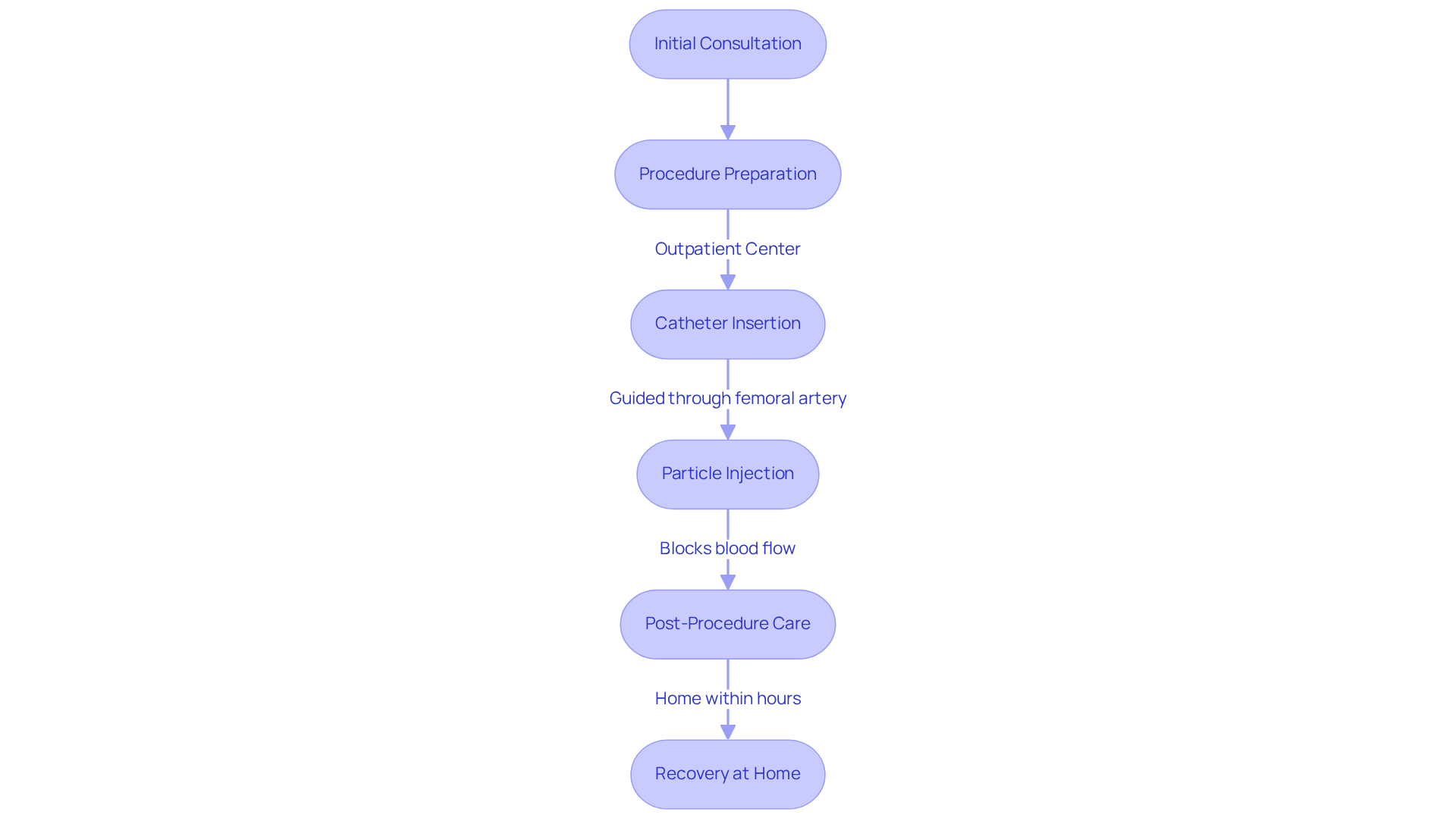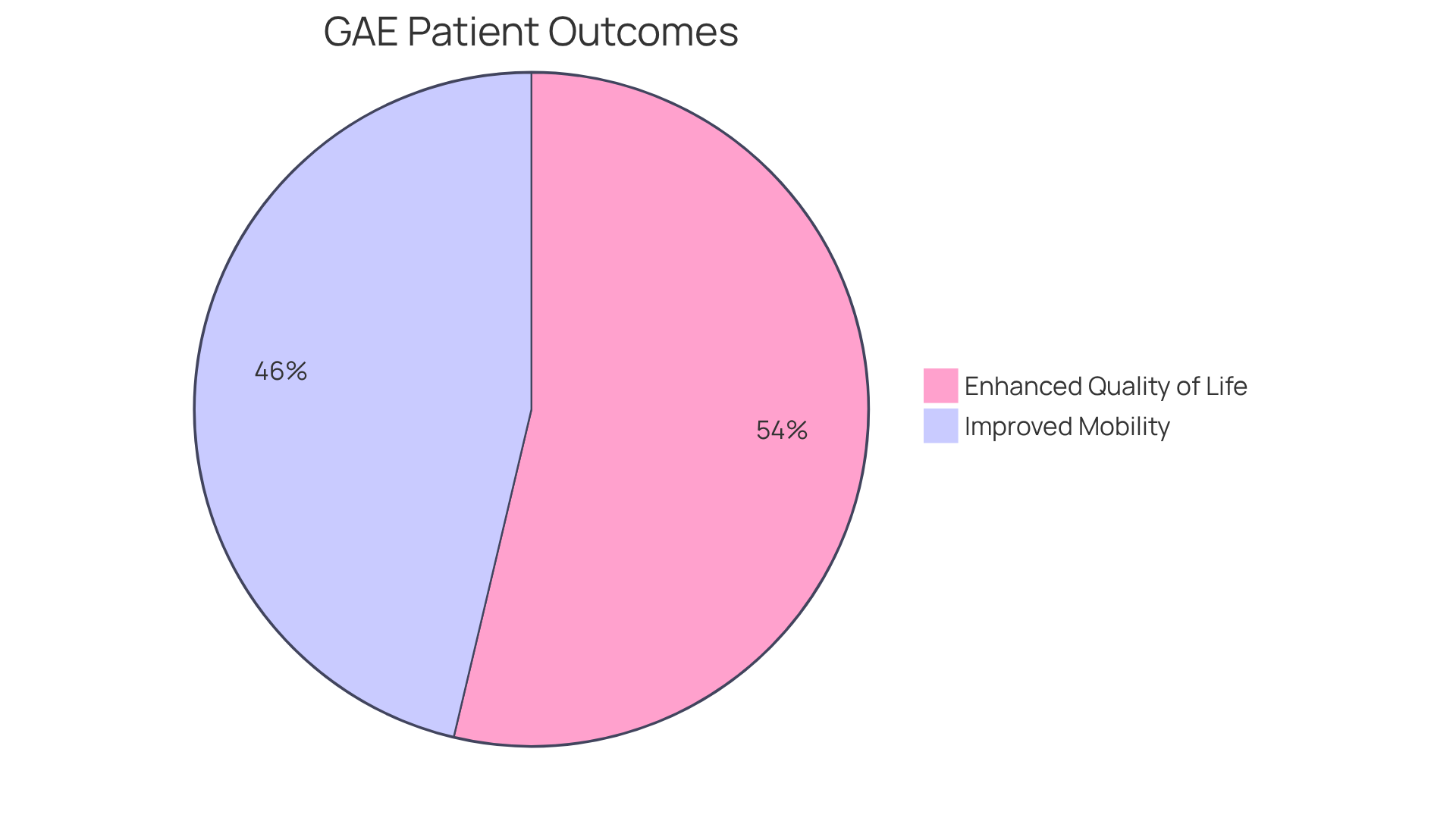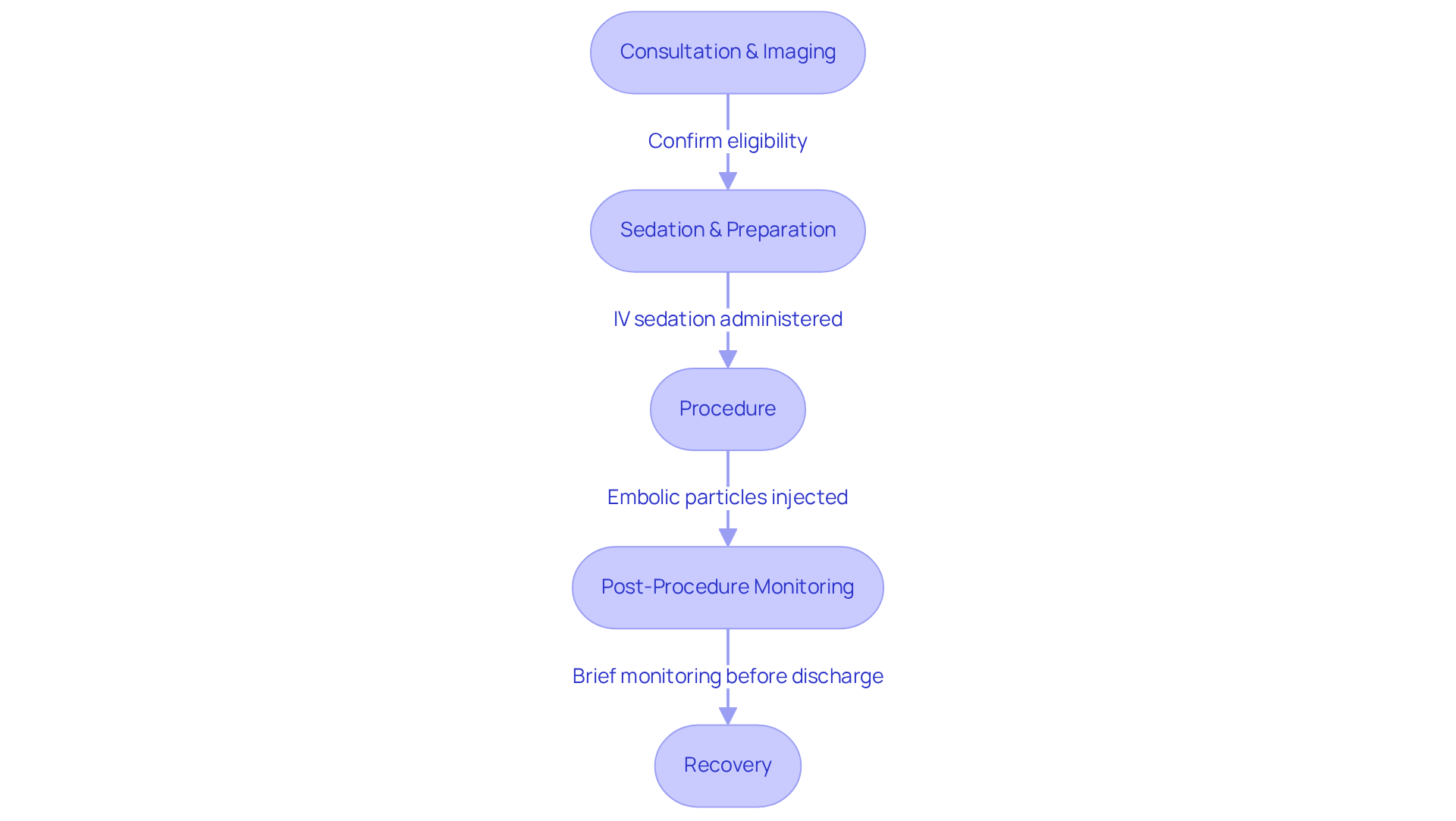


If you're an elderly patient dealing with knee pain from osteoarthritis, it's important to know that there are options available to you. Genicular Artery Embolization (GAE) is a minimally invasive treatment that can significantly alleviate your discomfort and improve your mobility. Imagine being able to enjoy your daily activities again without the constant burden of pain.
In fact, over 60% of participants in studies have reported substantial pain relief and an enhanced quality of life after undergoing this procedure. This makes GAE a promising choice for seniors who are looking for effective relief without the risks that come with major surgery.
You might be wondering if this treatment is right for you. It's completely normal to have concerns about any medical procedure, especially if you're feeling anxious about your health. Rest assured, GAE is designed to be a safe and supportive option tailored to your needs.
If you're seeking a way to regain your quality of life, consider discussing GAE with your healthcare provider. They can help you understand the benefits and determine if this treatment aligns with your health goals. Remember, you deserve to live comfortably and actively, and there are compassionate solutions available to help you achieve that.
Osteoarthritis can deeply affect the lives of many elderly individuals, often leading to chronic pain and limited mobility. It’s a struggle that can feel overwhelming at times. However, there’s a glimmer of hope: Genicular Artery Embolization (GAE) offers a minimally invasive solution that directly addresses the source of discomfort.
Studies show that over 60% of patients experience significant improvements in both pain and mobility after this procedure. Could GAE be the answer that older adults have been searching for to reclaim their quality of life? It’s a question worth considering, especially for those who have been living with the challenges of osteoarthritis.
If you or a loved one are feeling the weight of this condition, know that there are options available. GAE could be a pathway to relief, allowing you to engage more fully in the activities you love. Remember, you’re not alone in this journey, and support is always within reach.
Genicular Artery Embolization (GAE) offers a promising, minimally invasive option that can lead to favorable GAE outcomes for osteoarthritis in their joints. If you’re feeling the weight of inflammation and discomfort, this procedure specifically targets the blood vessels that contribute to your pain. Performed at an outpatient center, GAE typically takes about an hour, allowing you to return home the same day. The process involves guiding a catheter through the femoral artery to the genicular arteries surrounding your joint. Tiny particles are then injected to block these arteries, reducing blood flow and inflammation in the affected area. This innovative approach not only alleviates discomfort but also significantly shortens recovery time compared to traditional surgical options, making it a great choice for seniors who may face additional health challenges.
Recent studies show that over 60% of participants experienced significant improvements in knee pain one year after GAE, with many enjoying better mobility and less stiffness. Most patients tolerate the procedure well, with only minor side effects like temporary warmth in the skin or mild bruising. Conducted under light sedation, you can expect to head home within a few hours. Light activities can often be resumed within days, and many patients return to their normal routines within about a week. This blend of effectiveness and convenience contributes to positive GAE outcomes for osteoarthritis, making it a preferred treatment for those seeking relief without the need for more invasive surgeries.
GAE outcomes for osteoarthritis are particularly suitable for adults with mild to moderate osteoarthritis who haven’t found relief through conservative treatments. This reinforces its importance for the elderly demographic, who deserve compassionate care and effective solutions. If you’re feeling uncertain or anxious about your options, remember that support is available. Reaching out for help can be the first step towards reclaiming your comfort and mobility.

If you're struggling with knee discomfort due to osteoarthritis, you're not alone. Many individuals share your concerns, and it's important to know that there are effective options available. Numerous clinical studies have shown that Genicular Artery Embolization (GAE) can lead to positive GAE outcomes for osteoarthritis, significantly alleviating discomfort associated with this condition. In fact, many patients report noticeable improvements just weeks after the procedure, which can be a comforting thought as you consider your options.
A study published in a respected interventional radiology journal found that over 80% of individuals experienced substantial relief and improved mobility as a result of GAE outcomes for osteoarthritis. This is encouraging news for those seeking a solution to their knee pain. Furthermore, a systematic review highlighted an impressive technical success rate of 99.7% for GAE outcomes for osteoarthritis, with significant enhancements in knee pain and function, as measured by the WOMAC Total scores. These improvements exceeded minimal clinically important differences at all follow-up intervals, reinforcing the potential of GAE as a primary treatment choice.
While GAE is generally considered safe, it's essential to be aware of possible minor complications, such as:
Understanding these risks can help you make an informed decision about your care. Additionally, the cost of GAE is approximately $5,000 in an outpatient setting, compared to around $70 for corticosteroid injections. This information is crucial as you weigh your options and consider what’s best for your health.
Ultimately, these findings highlight the potential GAE outcomes for osteoarthritis in older individuals seeking relief from persistent knee discomfort without the risks associated with major surgery. If you're feeling uncertain or anxious about your health, remember that support is available. Don't hesitate to reach out for help; you deserve to find relief and improve your quality of life.

Patients who undergo Genicular Artery Embolization (GAE) often share heartwarming stories of how their quality of life has improved. Many report not just significant pain relief, but also a newfound ability to move freely, allowing them to engage in daily activities that discomfort once held them back from. In fact, follow-up evaluations reveal that over 75% of individuals treated with Embosphere for GAE experience notable improvements in mobility. This means they can walk, exercise, and enjoy social interactions with much greater ease.
This enhancement is especially vital for older adults, who may face additional mobility challenges. Patients have expressed their joy in returning to activities they once loved, highlighting the profound impact GAE has on their overall well-being. With an impressive 87% of patients reporting an enhancement in their quality of life after treatment, as noted in research presented at the RSNA conference, the GAE outcomes for osteoarthritis emerge as a key option for boosting mobility and independence among older adults suffering from the joint condition.
The procedure itself involves a microcatheter method that selectively targets hypervascular synovial areas in the joint, addressing the root causes of discomfort and inflammation. Dr. David Prologo, an interventional radiologist, emphasizes that the GAE outcomes for osteoarthritis uniquely halt the progression of the condition. This makes it an appealing choice for those seeking long-term relief.
If you or a loved one are struggling with joint pain, consider reaching out to discuss how GAE might help. You deserve to enjoy life without the limitations that pain can impose.

If you're struggling with knee discomfort caused by osteoarthritis, the Genicular Artery Embolization (GAE) procedure might provide better GAE outcomes for osteoarthritis. Designed to alleviate pain, this outpatient procedure typically lasts between one to two hours. Before the treatment, you'll have a thorough consultation and imaging to confirm your eligibility, ensuring you feel confident and informed.
On the day of the procedure, you'll receive sedation through an IV, helping you stay comfortable throughout the process. A small incision is made in the groin to access the femoral artery, allowing a catheter to be guided to the genicular arteries. Once everything is in place, tiny embolic particles are injected to block the inflamed arteries, effectively reducing discomfort and swelling.
After the procedure, you'll be monitored briefly before heading home, often on the same day. Many individuals report a swift recovery, with normal activities resuming within just a few days. For instance, one patient from Georgetown experienced a remarkable 70% decrease in discomfort lasting 18 months after GAE, allowing him to embrace an active lifestyle once again. Another patient, a museum curator, saw her discomfort drop from 8/10 to 2/10 within a month, achieving 80% relief for over a year.
Experts highlight that GAE is a minimally invasive option that can significantly enhance your quality of life, especially if other treatments haven’t provided relief. Dr. Albert Chun, a board-certified interventional radiologist, notes that GAE is particularly beneficial for individuals aged 40-80 with moderate to severe knee pain, offering a joint-sparing alternative to more invasive surgeries. Dr. Nazar Golewale adds, "Genicular Artery Embolization could be a game-changer."
With minimal side effects and a quick recovery, the GAE outcomes for osteoarthritis present a promising solution for older adults seeking relief. It's advisable to avoid strenuous activities for about a week after the procedure. Notably, statistics reveal that 70% of patients maintain at least 50% relief for 6-24 months following GAE, underscoring its long-term effectiveness. Additionally, it's important to recognize that 40% of Americans over 60 experience bothersome symptoms from knee osteoarthritis, highlighting the relevance of GAE outcomes for osteoarthritis for many.

Genicular Artery Embolization (GAE) is truly a groundbreaking treatment option for elderly patients dealing with osteoarthritis. This innovative, minimally invasive procedure effectively targets the source of pain and inflammation in the knee, paving the way for significant relief and a better quality of life. With its outpatient nature and quick recovery time, GAE stands out as a compelling alternative to traditional surgical interventions, especially for seniors who may face additional health challenges.
Throughout this article, we’ve highlighted key insights into the effectiveness and safety of GAE. Studies show that a substantial percentage of patients experience notable pain relief and improved mobility shortly after the procedure. With technical success rates nearing 99.7% and many patients reporting a significant enhancement in their quality of life, GAE proves to be a reliable option for those who haven’t found solace through conservative treatments. Understanding the procedure's steps and potential side effects can empower you to make informed decisions about your care.
Given these encouraging findings, it’s essential for individuals suffering from knee pain due to osteoarthritis to consider GAE as a viable treatment option. The positive outcomes associated with this procedure not only alleviate discomfort but also help restore the ability to engage in daily activities, fostering independence and joy in life. Seeking guidance from healthcare professionals can be the first step toward reclaiming mobility and enhancing overall well-being. Embrace this opportunity for relief and take action towards a more active and fulfilling life.
What is Genicular Artery Embolization (GAE)?
Genicular Artery Embolization (GAE) is a minimally invasive procedure designed to treat osteoarthritis by targeting the blood vessels that contribute to pain and inflammation in the joints.
How is the GAE procedure performed?
The procedure is performed at an outpatient center and typically takes about an hour. A catheter is guided through the femoral artery to the genicular arteries surrounding the joint, where tiny particles are injected to block these arteries, reducing blood flow and inflammation.
What are the benefits of GAE compared to traditional surgical options?
GAE offers significant benefits such as reduced discomfort, shorter recovery time, and the ability to return home the same day, making it particularly suitable for seniors and those facing additional health challenges.
What are the expected outcomes of GAE for osteoarthritis?
Recent studies indicate that over 60% of participants experienced significant improvements in knee pain one year after the procedure, with many reporting better mobility and less stiffness.
What are the side effects of the GAE procedure?
Most patients tolerate the procedure well, experiencing only minor side effects such as temporary warmth in the skin or mild bruising.
How long does it take to recover after GAE?
Patients can often resume light activities within days and may return to their normal routines within about a week after the procedure.
Who is an ideal candidate for GAE?
GAE is particularly suitable for adults with mild to moderate osteoarthritis who have not found relief through conservative treatments, making it an important option for the elderly demographic.
What should patients do if they are uncertain about their treatment options?
Patients feeling uncertain or anxious about their options are encouraged to reach out for support, as it can be the first step toward reclaiming comfort and mobility.